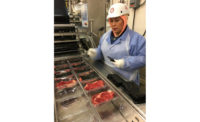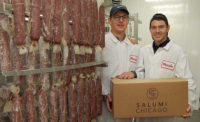“In our mind's eye, a big piece of where we were successful was in contiguous space, not running two or three plants,” explains CMA president Jordan Dorfman.
Dorfman started the business on January 22, 1990, with 10,000 square feet of space. The company's main businesses at the start were boning and value-added further processing, and those remain as the company's biggest markets. The boning side does approximately 1.4 million to 1.5 million pounds weekly of beef and pork cuts and sells most of it to further processors, including deli-meat companies, grinders and sausage makers, for use as ingredients. The portion-control operation supplies more than 500,000 pounds weekly to broadline distributors, national and regional restaurant chains, and big box stores.
While the many expansions helped both sides of the business prosper, there were some problems in having everything under one roof.
“It was a zoo, with frenetic energy but a lot of inefficiencies,” Dorfman recalls. He added that the company was operating at about 105 percent capacity with the one plant.
“It thinned our opportunities to grow our business, because the only way we were able to grow our business was to get rid of business in the interest of getting better business. But we liked all the business that we had, and we didn't want to get rid of any, so that meant we needed to open ourselves up.”
In 2008, an opportunity arose that was too good to pass up, and that September, Chicago Meat Authority opened its second processing plant - right across the street from its headquarters. The original building is now 65,000 square feet in size, and the addition of the new facility gives the company a total of 85,000 square feet.
This new CMA campus, with a North Plant and a South Plant, is not only extremely easy to manage but also gives the company room to grow. Dorfman estimates the company now runs near 65 percent capacity.
“We [are] able to grow the business from the approximately two million pounds per week that we do now to three million pounds, out of our existing infrastructure and perhaps a modest amount of capital expenditures, either this summer or next,” he says.
Executing a plan
Even though the company appeared to have had bad timing in opening a large expansion right as the U.S. economy went off the rails, Chicago Meat Authority hasn't slowed down. Jordan jokes that the company is “too small to struggle.”
“Our struggle is to not fall into the trap of believing that because the economy is struggling, there's no room for opportunity,” he adds. “To me, it's a matter of building a plan and executing a plan. I don't understand failure to execute.”
Chicago Meat Authority has developed a strong reputation for execution in its 20 years in operation. It's never been known as the lowest-cost processor, and Dorfman realizes that commodity buyers won't consider the value-added services that CMA offers as important. The company prefers working with customers that are looking for something special they haven't been able to find elsewhere, whether that “something special” is a product solution, a service solution or something else.
“If they need delivery three times a day because they don't have cooler space, we can get it to them,” Dorfman says. “If they need trimming that is assured of having all the glands removed, or all the cartilage and skin removed, that's an area we specialize in.”
He adds that the company often can provide its customers with an option they don't even realize is possible. Many of the company's customers are further processors who are outstanding in the fields of formulation, cooking, packaging and branding, but they don't have the resources to have a table full of people trimming meat, or keep up with outputs that change drastically from week to week. CMA can provide those processors with product trimmed to the exact specifications and quantities.
Chicago Meat Authority's versatility gives it the ability to incorporate new developments in packaging or new cuts of beef for its retail customers. The company was the first to use a package that puts the meat and the marinade into two separate chambers of the same package. When the consumer is ready to prepare the meal, he or she can break the seal between the two chambers and marinate the meat at the desired time.
Dorfman notes that the marinade doesn't end up interacting with the meat for months at a time, providing a better texture and flavor when the meat is cooked. He adds that that package helps the company in its mission of adding value, “for the homemaker who is stressed for time but wants to produce a meal made from scratch,” he says. “Now you can get a higher-quality marinade with a better flavor and family satisfaction, with very little fuss and muss, and the sense of pride of having produced a meal virtually from scratch.”
CMA took the packaging to Schwan's, one of its customers, and the company was very interested in the concept.
“We built the marinades, we built the meat block, we worked with the price point and the packaging,” Dorfman says. It introduced products like Schwan's “Marinade on Demand” Chimichurri Beef and Herb and Garlic Pork, and the concept ended up winning the 2010 Flexible Packaging Association Highest Achievement Award in its annual awards competition.
CMA works as being just as resourceful when it comes to its foodservice customers, especially considering the economic struggles that sector has gone through.
“We found that customers are looking for unique solutions on how to get more out of [the] $5.99 that [consumers] have to go out,” Dorfman explains. “Having never been known for cutting Prime, aged steaks, we are a little bit more innovative and partner with our customers to come up with value solutions.”
The company has worked with the National Cattleman's Beef Association to come up with value cuts, such as Flat Iron steaks and clod heart steaks, typically with flavors or seasonings.
“We're able to take a raw material that's a bit more in the customer's new sweet spot,” he says. “We've benefited from the fact that consumers seem to be trading down in price point, but do not want to give up on quality [and] are willing to give up on more traditional cuts that everyone knows by name."
Five-year plan
Chicago Meat Authority has always worked with a five-year plan in order to keep the company and its deboning and portion-control businesses growing smoothly. Both businesses have now reached a critical mass, Dorfman explains, to the point that splitting the operations and going in two distinct directions under different leadership may make sense.
“We see a more decentralized organizational structure in the future,” he says, “but where each piece complements the other.”
Doing that will allow both divisions to grow and give the company a chance to enter into new markets, such as the cooked meats business, likely through acquisition.
As a result, the company is focusing even more on its human-resources strategies and organizational development, in order to train its current team and bring in the right people for the future. Dorfman says he is looking for “stretch leadership,” people who a couple of years from now will have grown and be in a position to take advantage of new opportunities within the company. He is expecting his own role to change from a more tactical leadership position to one that's more strategic.
“A lot of my discretionary time is spent working with my senior VP of corporate strategy and putting the cogs in place so that the company can grow much larger than my personal capacity, by building the organizational capacity,” he says. His “discretionary time” comes when he's not involved with key customers, operations, sales and purchasing.
In its first year in operation, Chicago Meat Authority enjoyed $6 million in sales. This year, the company's goal is to break the $100 million mark. Of course, Dorfman is already looking ahead for the next milestone.
“I didn't know how to run a $6 million company when I started, but I had to,” he says. “I never thought I'd be able to run a $150 million company, but I'll have to.
“What's the next step for us?” he asks. “It's $150 million, which means I'm going to need a lot of help - but there are real opportunities out there to get it.”






